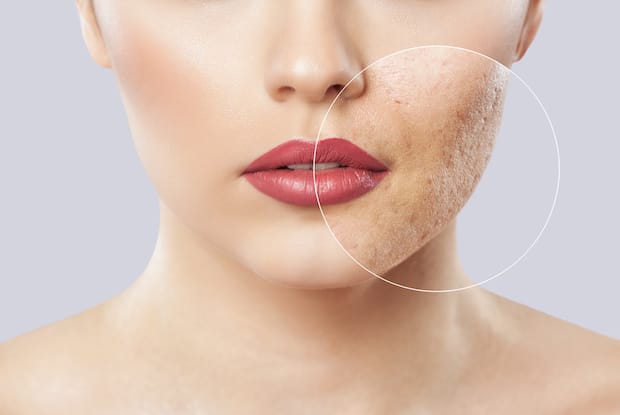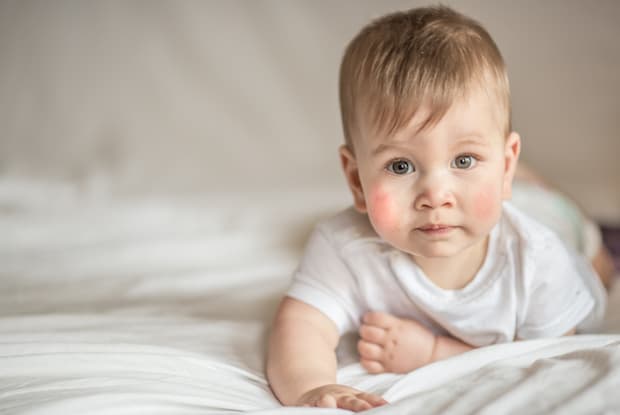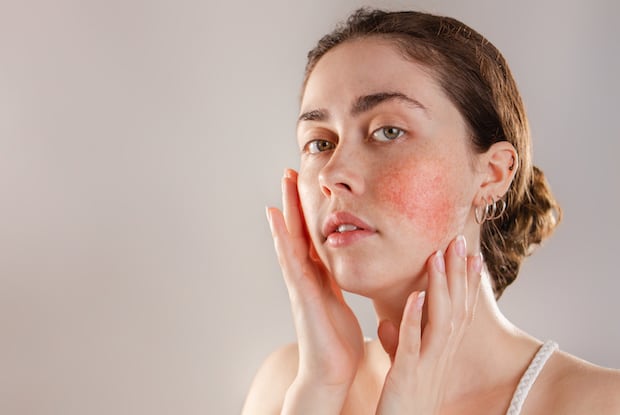Table of Contents
Overview
There are many different skin conditions that affect the human body. Skin disorders can vary significantly. While most skin disorders are mild, severe conditions such as skin cancer can become life-threatening. Common symptoms of skin disorders include itching, oozing, inflammation, and breaking out in pimples.
There are more than 3,000 known skin disorders. [1] Keep reading to learn about some of the most common conditions, including their causes, symptoms, and treatments available.
Acne
a. What is Acne?
Acne is the most common skin condition in the United States and affects approximately 50 million Americans each year. [2] The condition can affect people of any age, although it is most common in teenagers and young adults. During adolescence, acne is more likely to affect males. However, females are more likely to get adult acne. [3] Acne causes many different types of pimples and other blemishes. These are most common on the face but can also occur on the neck, shoulders, chest, and back. [3]
There are three major causes of acne: Almost all skin pores contain the opening to a follicle. Follicles contain both a hair and a sebum oil gland. Sebum oil is used to keep the skin soft, but when there is an issue with this process, then acne can occur. There are several different medications available to treat acne. Depending on the severity and persistence of the condition, patients may need to use several forms of treatment. Typically, acne medications come in topical forms such as creams and lotions that are applied directly to the affected skin area. Common topical medications include Azelex (azelaic acid) and Retin-A Cream (tretinoin). When using these medications, it is important to use them every day. If they are ineffective, your doctor may prescribe antibiotics. It is also important to keep skin clean and exfoliated, but do not overdo these things. You should wash your face with mild soap and pat dry in the morning, evening, and following any activity that has caused sweating. Overly frequent or violent washing may irritate the skin and worsen acne. Eczema is another common skin condition and is particularly prevalent in children. Also known as atopic dermatitis, eczema affects around 35 million Americans. Around 70 percent of eczema cases begin when the patient is younger than five. [5] The symptoms of eczema can vary between patients. Commonly, eczema causes the skin to become dry, cracked, thick, scaly, swollen, or sensitive. Eczema can make the skin very itchy and this may be more severe during the night. Other symptoms include small, raised bumps or red, gray, or brown patches that appear on the skin. [6] It is believed that eczema is a hereditary condition. Normal, healthy skin has an outer barrier that helps keeps your skin moisturized and protects you from bacteria and other irritants. For people with eczema, this outer layer is weaker, allowing irritants to cause dryness and itchiness. [7] There is no known cure for eczema, but treatments can help relieve itching and reduce the likelihood of outbreaks. Many eczema medications are applied directly onto the skin. Calcineurin inhibitors such as Protopic (tacrolimus) and Elidel (pimecrolimus) help reduce eczema inflammation. If topical medications are ineffective, or the eczema is not confined to one area of the body, doctors may prescribe oral medications that slow down your immune system response. Along with medication, lifestyle changes may help prevent flares of eczema. Changes can include moisturizing twice a day, taking shorter baths, showering with warm water, and patting yourself dry carefully. Different people may have different eczema triggers. For children, especially, it can be food-related. It may help to keep a diary of what foods your child eats, and how their eczema is affected. [6] Rosacea is a skin condition that causes visible redness and skin bumps similar to acne. It affects approximately 16 million Americans, although there may be millions more in temporary remission. [8] Anyone can be affected by rosacea. However, it is most common in middle-aged, light-skinned women, especially those with a family history of the condition or those that smoke. [9] Typically, rosacea causes facial redness when blood vessels in the nose and cheeks swell and become visible. Your skin may also become tender and warm to the touch. Many rosacea patients also develop pimples containing pus. Another common symptom of this condition is swollen eyes and eyelids. Dry and irritated eyes are sometimes the first symptom of rosacea. As time goes on, skin on and around the nose may thicken, causing a bulbous nose, especially in men. [9] There is no known cure for rosacea. However, the symptoms can be controlled and reduced with treatment. Medications to treat this condition are, once again, usually topical creams and gels. Common medications include Azelex (azelaic acid) and Soolantra Cream (ivermectin). The cause of rosacea is unknown, although it is thought to be a combination of genetic and environmental conditions. Flare-ups may be triggered by several things, including exercise, extreme temperatures, medications, emotions, sunlight, wind, hot drinks, spicy foods, and alcohol. [9] It can be beneficial for rosacea patients to keep a diary of when symptoms appear, which may help identify and avoid personal triggers. Psoriasis is another chronic skin disorder. It affects over eight million people in the United States and around 125 million worldwide. [10] The condition causes the skin to become red, itchy, and scaly. While this disorder can affect any part of the body, it is most common on the scalp, knees, elbows, and lower back. Usually, psoriasis only affects a few areas of the body, although in severe cases it may cover large body areas. [11] It is thought that psoriasis is caused by a problem with the immune system. Typically, psoriasis occurs in episodes that last a few weeks or months before going into remission. Mild to moderate psoriasis is most commonly treated using prescription corticosteroids, such as Temovate (clobetasol) or Cortef (hydrocortisone). For more severe cases of psoriasis, doctors may prescribe light therapy. Light therapy may be prescribed alone or alongside prescription medications. Repeated treatments of light therapy may be required for severe psoriasis. The content in this article is intended for informational purposes only. This website does not provide medical advice. In all circumstances, you should always seek the advice of your physician and/or other qualified health professionals(s) for drug, medical condition, or treatment advice. The content provided on this website is not a substitute for professional medical advice, diagnosis, or treatment.
b. How is Acne Treated?
Eczema
a. What is Eczema?
b. How is Eczema Treated?
Rosacea
a. What is Rosacea?

b. How is Rosacea Treated?

Psoriasis
a. What is Psoriasis?
b. How is Psoriasis Treated?
